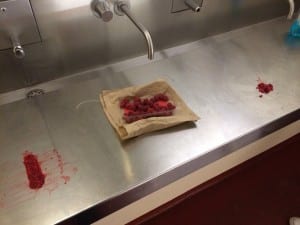Within this session of exploration we began by focusing on ourselves in the mirror for 10 minutes. Whilst doing this, some women came into the toilets, which provided us with a good opportunity for us to gauge their reaction – they reacted by not reacting. Possibly embarrassed, they ignored us, even though we were standing slightly in the way of the sinks; they did their best to avoid all form of contact, evidently averting their gaze as much as possible. From this, we knew that our performance was disconcerting but we also knew that it was not provoking a reaction that we wanted. To achieve the desired reaction therefore, we knew we needed to frame our performance so people knew that something was happening.
We put into practice our food inspiration from Bobby Baker, crudely squashing raspberries onto the sink and then applying it as lipstick and blusher on our faces. “We are taught from a young age not to play with our food which is precisely what Baker is doing. She ‘…want[s] to re-awaken that delight which is lost or very formalized into society’s obsession with cooking.” (glowby, 2012 ) By incorporating the mashing up of the berries into our performance, instead of using a premade mix, re-enforces the idea of childhood behaviour that contrasts to the ‘grown-up’ ideal of makeup. The playful nature of mashing up raspberries and putting it on our face, can bring up thoughts of a child rummaging through their mothers purse and wanting to play ‘dress up.’ By acting in this way, we felt it created a deeper underlying reference to the fact that within western society today, the age of girls wearing makeup is becoming increasingly lower largely due to the changing standards of the cultural norms of society using girls as models.
Bobby Baker uses food in most of her performances to show her feminist thoughts, “through her use of food in performance she communicates her ‘everyday’ experiences as a wife, mother and artist.” (Lawson, 2009) Using the raspberries, we thought we could achieve a similar message but as young adults challenging views on the conformity of wearing makeup. In all our previous practices of just staring in the mirror, no-one paid much attention to us and mainly ignored us. This time, however, because there was more of a non-conformance action happening, we received some concerned and odd looks from the toilet users. Our actions were enhanced by the stark and bright colour of the raspberries on our cheeks and lips which was impossible to be missed, “Baker has stated ‘food is like my own language’ (Iball 75), and it is a highly visceral, visual language that she uses to communicate” (Lawson, 2009)
What I found interesting about our performance was the idea that if we had been applying ordinary red lipstick and blusher, no one would have cared or noticed it at all. But by using childlike play practices to simulate the adult actions of applying make-up, it drew attention not only to the need of many females to continually use make up to enhance their appearance, but also the inescapable conditioning of young girls by societal norms and media into needing to wear cosmetics too.
Works Cited
glowby (2012) Bobby Bakers’ Edible Performance Art 2012 [Online] Available from: https://glowbey.wordpress.com/2012/05/13/bobby-bakers-edible-performance-art/ [Accessesed: 6th April 2015]
Lawson. J (2009) Food Confessions: Disclosing the Self through the Performance of Food [Online] MC Journal. 12 (5)
Available from: http://journal.media-culture.org.au/index.php/mcjournal/article/viewArticle/199 [Accessed: 14th April]

Recent Comments